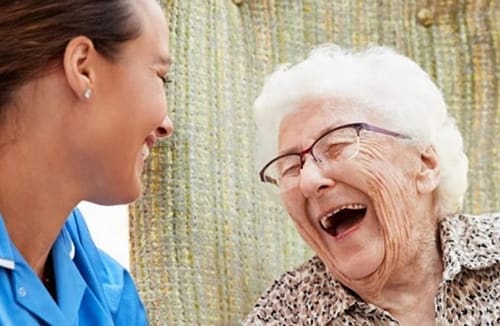For senior living communities, a positive caregiver experience is more than just job satisfaction and happiness. It’s something deeper. Caregiving is about being engaged and emotionally committed to your organization, its goals, and ultimately, the residents. That commitment is what compels a professional caregiver to go above and beyond the call of duty and provide exceptional care.
Employee experience might be a buzzword, but in the senior living community industry. it has a direct impact on resident satisfaction and a community’s success.
In fact, according to Gallop’s State of the Global Workplace Report:
“Organizations that score in the top quartile for employee engagement have almost double the success (composite financial, customer, retention, safety, quality, and absenteeism metrics) than those in the bottom quartile.”
So, how can community leaders enable and promote the caregiver experience and promote the caregiver experiences that match caregiver duties to skills? The answer includes technology and data-driven solutions.
The Challenge of Disengagement and Caregiver Turnover
Providing continued care for residents of a senior living community can be physically, mentally, and emotionally demanding. In some facilities, caregiver burnout happens far too often due to the demanding nature of working on a nursing care team.
Many caregivers are dissatisfied with the job when challenges go unresolved. A common sentiment amongst those who exit the industry is that they’re underpaid, overworked, and feel as if they’re not actually making a significant impact on healthcare outcomes. All these reasons can lead to caregiver burnout. This is why senior living communities have one of the highest employee turnover rates of any industry in the country.
For instance, in 2017, the turnover rate reached a whopping 75%, with the average cost to replace an employee ranging from $3,500-$5,000. For organizations with more than 100 senior care employees, employee turnover might cost them as much as $400,000 annually.
But the damage of a poor caregiver experience isn’t limited to just your bottom line. Caregiver turnover is detrimental to your community as a whole and can cause several problems for each resident that lives in your facility:
- Compromising care
- Disrupting the community culture
- Decreasing resident satisfaction
This poses both a challenge and an opportunity.
The challenge? Caregiver burnout.
The opportunity? To help caregivers focus their energy and time on the rewarding aspects of their job—which is interacting with and helping older adults.
Improving the Professional Caregiver Experience Through Automation
A major advantage of technology to any industry is the automation of redundant or routine tasks. For caregivers, technology is a great way to address many of their concerns from communication and workflow efficiencies, to easy access to information. In fact, the right technology means spending less time on things they dislike—boring, manual, rote tasks—and more time on the aspects of the job they do like—engaging with the resident and increasing the quality of care.
In theory, purposeful tech-enablement should be easy; in fact there are many tools that promise to simplify daily tasks. In reality, selecting and implementing the right tools, to solve the right problems, is inhibited by several issues:
- Legacy systems disrupt new systems. Because many communities view technology as a capital expense, which may need board approval to replace, they rely on inefficient and antiquated systems far too long with band-aids and “add ons” that don’t quite work the way they are supposed to.
- Caregivers are not usually technologically savvy. Most healthcare professionals join a community team because they want to help residents. By nature, they are not typically technologists. Technology that is not intuitive, with obvious benefits to themselves or the residents, will be pushed aside.
- The technology is not purpose-built, or is too purpose-built. Communities may choose a technology with many functions. This may make caregivers less efficient, and decrease their overall experience. According to the Conversation, “available technologies don’t meet caregiver needs very well. Many product designers and developers create the technology for the sake of it, without knowing whether caregivers want it or are prepared to use it.”
What Technology Will Have the Greatest Impact on Caregiver’s Experience?
Technology platforms that improve the caregiver experience work because they are built with the caregiver, and the resident in mind.
Help Caregivers Work More Efficiently – Technology should help healthcare professionals caregivers eliminate unnecessary tasks, respond faster to resident needs, and avoid adverse events with features that:
-
- Automate resident safety checks
- Create an alarm when a resident has failed to check in
- Route caregivers based on location
- Prepare for a call with accessible resident information
- Identify resident proximity to each other or exits
- Manage alarms and document services efficiently
- Eliminate tasks that should be provided by someone else
- Define boundaries for resident entry and exit
When successfully implemented, this saves time and makes resident care more effective. It drives caregiver engagement, enabling caregivers to better manage their time and focus on the aspects of the job that most need their attention.
Provide Data-Driven Insights – Identifying the best care decision quickly isn’t always easy. Sensor- and location-based technology can help by gathering large swaths of resident data, analyzing it, identifying potential issues and displaying the information graphically to help caregivers anticipate and act to prevent adverse events, ensuring better healthcare outcomes. Valuable insights come from solutions that:
-
- Assess resident and caregiver risk exposure quickly if an infection breaks the community barriers
- Identify residents who have become isolated for no apparent reason
- Notify caregivers if a resident is at risk for a fall or preventable medical condition
- Facilitate protocol management for residents with known personality issues, lockdown situations and wander detection
When caregivers have access to accurate, real-time information, they feel empowered to make wise and informed decisions. This reduces the complexity and uncertainty surrounding service coordination and care management.
Supports Intuitive Care Management – The foundation of smooth and efficient care often comes down to giving caregivers the ability to anticipate and respond to resident needs, all the while protecting their privacy. For that, you need to make your organizational data transparent. Today, there are several technologies that help provide the information and awareness your caregivers need to act early, including:
-
- Motion and environmental sensors gather and collate thousands of passive and active data points
- Location management helps identify people and equipment across your campus
- Continual unobtrusive analysis runs in the background for real-time feedback
By focusing on data transparency and surrounding caregivers with the data-driven tools and technologies they need, you empower them to make better, more informed care decisions.
Sentrics—The Caregiver Experience Solution
If you’re searching for a technology platform to help improve the caregiver experience, Sentrics360SM was built with that purpose in mind. Composed of four key components—Ensure360SM, Engage360SM, Entertain360SM, and Enrich 360SM—this AI-integrated platform helps keep your staff engaged, as well as changing your healthcare from reactive to proactive.
Ensure360 was created with caregiver experience in mind. It utilizes the most trusted eCall systems, motion and location sensors, and RTLS technology to answer who, what, when, where, and why. Armed with this data-driven tool, staff can provide proactive care, instead of waiting around for an incident to occur. This creates a host of benefits, including:
- Improved care
- Reduced staff burden
- More satisfied staff
With Sentrics as your technology partner, you surround your team with the tools they need to stay engaged and deliver the highest quality of care. By embracing the Sentrics solution and keeping staff engaged, you can reduce staff turnover, improve resident satisfaction, and create better care outcomes.
See for yourself how Sentrics can transform your senior living community today!
Sources:
- On Shift. Senior Care Staff Turnover By The Numbers & Why It Matters To You. https://www.onshift.com/blog/senior-care-staff-turnover-by-the-numbers-why-it-matters-to-you
- Gallop. State of the Global Workplace. https://www.gallup.com/workplace/238079/state-global-workplace-2017.aspx
- Senior Housing News. Why Senior Living Fares Worse Than Other Service Industries on Worker Turnover. https://seniorhousingnews.com/2019/11/22/why-senior-living-fares-worse-than-other-service-industries-on-worker-turnover/
- The Conversation. Using technology to support caregivers of older people with dementia. https://theconversation.com/using-technology-to-support-caregivers-of-older-people-with-dementia-122447



